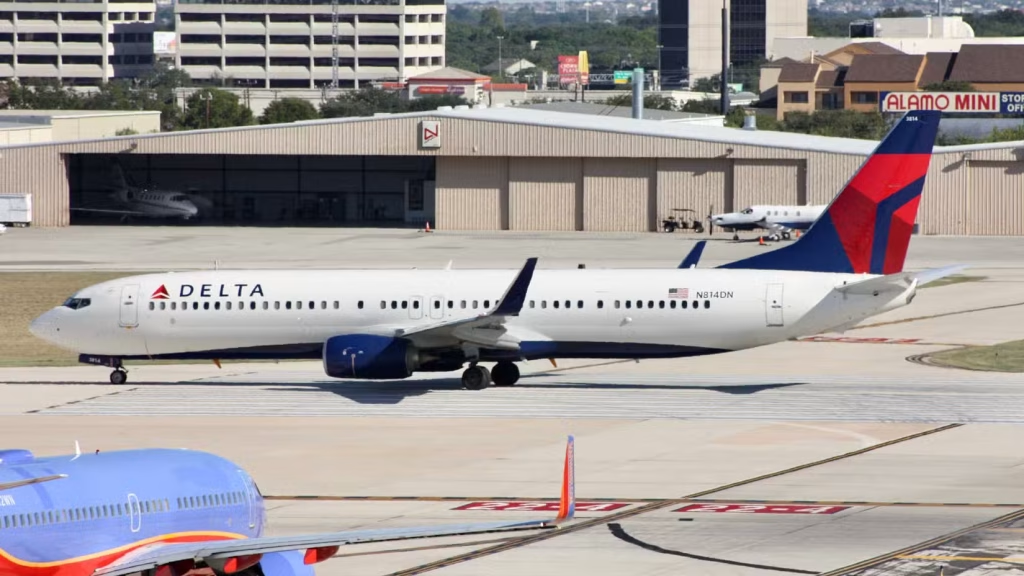Aviation News
Delta Air Lines Boeing 737-900ER Grounded After Engine Fails During Takeoff From Minneapolis–St. Paul
Just after takeoff from Minneapolis–St. Paul on October 23, 2025, Delta flight DL1661 suffered a Number 2 engine failure, prompting a high-speed rejected takeoff at 135 knots with 187 people aboard; passengers were moved to a replacement aircraft and the 737-900ER has been grounded for repairs, with emergency procedures resulting in no injuries.
An Engine Failure At Minneapolis
Delta Flight DL1661 (N829DN) experienced a failure in the Number 2 engine during the takeoff roll from MSP on October 23, forcing a high-speed rejected takeoff at 135 knots. With 187 people aboard the crew returned to the gate; passengers were later rehosted on N836DN while N829DN remains grounded.
Incident Description
During the roll on Runway 30L the crew received an indication of a fault in the right-hand (Number 2) engine, prompting the abort at 135 knots and a turn onto Runway 22; immediate checks focused on brake and tire condition because the high-speed stop posed a risk of overheated brakes and flat-spotted tires.
Immediate Response
Passengers and crew dislaunched safely and waited about two and a half hours for replacement 737 N836DN and a relief crew, while ground teams completed initial inspections and documented the event; the incident produced no injuries but left N829DN out of service pending deeper maintenance.
TechOps teams at MSP conducted visual brake and tire inspections, reviewed cockpit indications and maintenance logs, filed operational reports, and began follow-up troubleshooting — including engine-data downloads and borescope inspections — to determine whether repair, component replacement, or an engine-shop visit will be required before returning N829DN to service.
Overview Of The Aircraft
N829DN is a Boeing 737-900ER delivered to Delta in 2014 and one of 163 739-series jets in the carrier’s fleet. Delta’s 737-900ERs carry 180 seats (20 Delta First, 27 Delta Comfort, 133 Delta Main); this flight had 187 occupants and required two pilots and four attendants. The type is powered by the CFM56‑7B, and after the engine failure and high-speed RTO the airframe has been grounded in Minneapolis for inspection.
Boeing 737-900ER Specifications
The 737-900ER (739) in Delta service is configured for 180 passengers with a two-person flight crew and four cabin crew. It uses twin CFM56‑7B turbofans, retains Delta’s standard interiors, and is maintained to Part 121 standards. N829DN entered service in 2014 and sits within Delta’s 163-aircraft 737-900ER subfleet primarily used on medium-haul domestic routes.
Common Issues and Maintenance Records
CFM56-7B has a strong reliability record, though operators occasionally see fan-blade fatigue, compressor stalls or FOD-related damage; such events remain uncommon. After this incident crews logged immediate brake and tire inspections and the engine is slated for borescope inspection, oil-filter debris analysis and trend-data review. With the high-speed rejected takeoff at 135 knots and the aircraft grounded in Minneapolis, maintenance emphasis is on rotating hardware and heat-affected wheel assemblies, while the positive outcome was no injuries.
Technicians will pull HFDM and quick-access recorder files, perform an engine borescope to inspect fan, compressor and turbine stages, and check for oil-filter debris that indicates internal damage. They’ll review maintenance logs, life‑limited part serials and applicable ADs/service bulletins, may send modules for shop visit or replace LRU components, and coordinate with CFM and Delta TechOps to compare records across the 163-aircraft 737-900ER fleet to rule out systemic faults.
Impact on Passengers and Crew
Safety Protocols Activated
The flight crew executed a high-speed rejected takeoff after an indication of Number 2 engine malfunction at 135 knots, triggering standard emergency procedures. Ground teams immediately inspected brakes and tires and Delta TechOps began diagnostics on the affected CFM56-7B engine. FAA/airline reports were filed and a replacement crew was assigned under duty-time rules, with the incident handling focused on safety and aircraft integrity.
Passenger Experience
All 187 people were disbegined and later moved to replacement Boeing 737 N836DN, enduring roughly a two and a half hour delay; scheduled 17:27 arrival shifted to 19:59 per Flightradar24. Gate staff managed reboarding and information flow, and there were no injuries reported.
Delta configures the 737-900ER with 180 seats, so the manifest’s 187 occupants indicates a jumpseater or extra authorized occupant was aboard; passengers waited while TechOps worked on grounded N829DN and replacement crew duty-time limits were resolved, extending the turnaround before departure on the relief aircraft.
Investigation into the Incident
Investigative Agencies Involved
Investigation is being led by the NTSB, with technical support from the FAA, Delta TechOps at Minneapolis, Boeing and engine manufacturer CFM International. Airport operations and local responders who assisted during the high-speed rejected takeoff are also providing statements and data. Flight data and cockpit voice recorders, maintenance logs for N829DN, and serial-numbered engine components will be shared among agencies for parallel analysis.
Preliminary Findings
Initial data show a Number 2 engine indication during the takeoff roll prompting a high-speed RTO at about 135 knots</strong); the aircraft, N829DN, carried 187 occupants and returned to gate with no injuries. On-scene inspections focused on brakes and tires; the engine was removed for further teardown. Investigators are comparing maintenance records, recent borescope inspections and engine health-monitoring logs to isolate the failure mode.
More detailed examination has begun: borescope imagery, oil debris analysis and FADEC/event log downloads will determine whether the fault was mechanical (blade, shaft, or bearing), accessory-driven (oil, fuel, or gearbox), or sensor/control-related. Teams will catalog component serial numbers against service bulletin and AD histories, inspect the removed CFM56-7B for stage-wise damage, and review the last shop visit and cycles since overhaul. Given the lack of reported airframe damage and no injuries, investigators are treating this as a potentially contained engine failure but will verify whether fragments breached casings, examine wear patterns, and cross-check similar events across Delta’s 163 737-900ERs to rule out systemic issues.
Future Implications for Delta Air Lines
Operational Changes
Delta will initiate targeted inspections of the affected CFM56-7B engines across its 163 737-900ERs, prioritizing N829DN’s engine serial and any same-lot units. Technicians at Delta TechOps Minneapolis can perform immediate borescope checks, maintenance-record audits and engine health monitoring. Operations will also formalize enhanced rejected-takeoff drills after the high-speed rejected takeoff at 135 knots and increase spare-aircraft and crew reserves to cut the risk of future long delays.
Trust and Reputation Management
Public messaging should underscore the positive safety outcome — no injuries — while clearly explaining steps taken for the grounded N829DN and fleet inspections. Timely updates about findings, repair timelines and cooperation with NTSB/FAA, combined with refunds or vouchers for the 187 passengers delayed about 2.5 hours, will be important to limit reputational impact.
For deeper recovery, Delta can publish interim findings within 72 hours, detail repair work performed at Delta TechOps, and report inspection counts (for example, borescope checks across the 163 737-900ERs). Providing measurable metrics — on-time performance, complaint rates and compensation issued — plus follow-up safety briefings creates transparent evidence of corrective action.
What Will Happen Next
Investigators will prioritize engine teardown, borescope and metallurgical analysis of the failed CFM56-7B module, and a review of N829DN’s maintenance logs and recent shop visits. Delta TechOps in Minneapolis will support with on-site repairs and parts sourcing. The high-speed RTO at 135 knots and the presence of 187 occupants mean inspectors will also scrutinize brakes, tires and systems for heat or overload damage; the findings will dictate rapid return to service or extended maintenance.
Expected Timeline for Investigation
Initial evidence gathering and engine borescope or tear-down should occur within 72 hours, with metallurgical lab tests running days to weeks. A preliminary factual update is typically available in 7–14 days, while a comprehensive NTSB/FAA factual report can span 6–12 months, and a final probable-cause determination may take up to 12–24 months if complex component forensics or fleet implications arise.
Potential Regulatory Responses
Regulators will weigh whether an emergency airworthiness directive (AD) or mandated inspections are warranted across Delta’s 163 737-900ERs and the thousands of CFM56-7B engines in service. Actions could include immediate borescope or ultrasonic checks, FAA airworthiness alerts, mandated service bulletins from the manufacturer, or targeted enforcement and revised maintenance intervals if the fault points to procedural issues rather than a design defect.
As precedent, the 2018 Southwest Flight 1380 fan-blade fracture led the FAA to issue ADs requiring enhanced fan-inspection protocols and accelerated ultrasonic inspections on affected CFM56-7B engines. If fatigue, manufacturing anomaly or maintenance deviation is identified here, regulators would likely apply that same playbook: targeted ADs, mandated inspection intervals, and industrywide service bulletins to ensure rapid, uniform compliance.
Summing up
On the whole, Delta’s Boeing 737-900ER that suffered a Number 2 engine failure and a high-speed rejected takeoff at Minneapolis on October 23 was safely evacuated, with passengers rebooked and no injuries reported; the airframe remains grounded for inspection and repair at Delta TechOps while investigators evaluate maintenance records and the isolated engine fault.
Frequently Asked Questions — Delta Air Lines 737-900ER Engine Failure
What happened to the Delta Air Lines Boeing 737-900ER?A Delta Air Lines Boeing 737-900ER experienced an engine failure during takeoff from Minneapolis–St. Paul International Airport. The flight was safely aborted, and all passengers disembarked without injury.
Were there any injuries reported?No injuries were reported. Delta confirmed that all passengers and crew were safely returned to the terminal after the aircraft was grounded for inspection.
What caused the engine failure?Initial assessments suggest a possible mechanical fault in the right-hand engine. A full investigation by Delta’s maintenance team and the FAA is underway to determine the root cause.
How common are engine failures during takeoff?Engine failures during takeoff are extremely rare. Modern aircraft like the Boeing 737-900ER are designed to safely abort takeoff or continue flight on one engine if needed, ensuring passenger safety.


